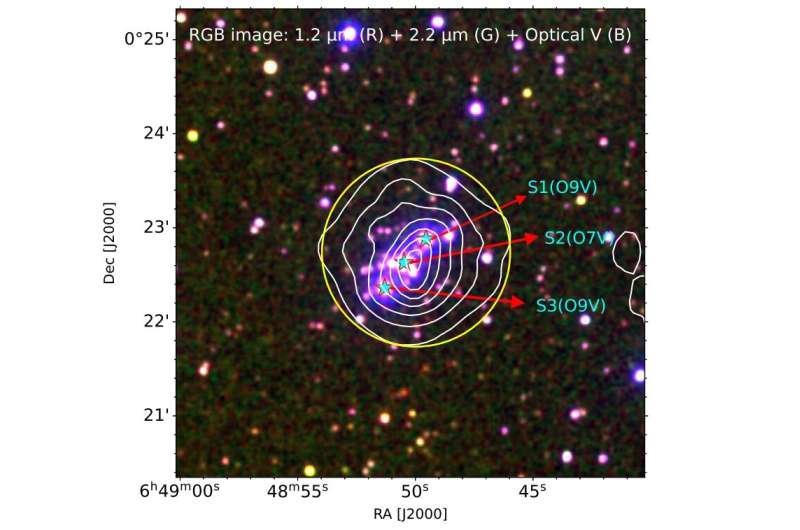May 9, 2023 report
Deep optical photometric observations of the open cluster Bochum 2

Tomasz Nowakowski
astronomy writer

Indian astronomers have carried out deep optical photometric observations of the Galactic open cluster Bochum 2 using the 1.3m Devasthal Fast Optical Telescope (DFOT). Results of the observational campaign, published May 2 on arXiv, deliver important insights into the properties of this cluster.
Open clusters (OCs), formed from the same giant molecular cloud, are groups of stars loosely gravitationally bound to each other. So far, more than 1,000 of them have been discovered in the Milky Way, and scientists are still looking for more, hoping to find a variety of these stellar groupings. Expanding the list of known galactic open clusters and studying them in detail could be crucial for improving our understanding of the formation and evolution of our galaxy.
Bochum 2 (or Boc2 for short) is a young OC in the far northern outskirts of a giant star-forming H II region (containing clouds of ionized atomic hydrogen) known as Sh 2−284. Although Bochum 2 has been known for decades, it is a poorly studied cluster, and there are many uncertainties regarding its fundamental parameters, like distance and age estimates, as previous studies were based mainly on shallow optical data.
Therefore, in order to better determine the properties of Bochum 2, a team of astronomers led by Harmeen Kaur of the Kumaun University in Nainital, India, has employed DFOT to conduct deeper photometry of this cluster. Their study was complemented by data from the Gaia Data Release 3 (DR3).
"We have performed deep (V∼21.3 mag) and widefield (FOV ∼ 18.5 × 18.5 arcmin2) multiband (UBV Ic) photometric observations around the Boc2 cluster," the researchers wrote in the paper.
The observations found that Bochum 2 has a radius of 3.6 light years, while its tidal radius is about 6.4–8.2 times greater. This suggests that most of the stars in this cluster are the remnants of an older population of stars formed via an earlier epoch of star formation.
According to the study, Bochum 2 has a reddening at a level of some 0.8 mag and is located approximately 12,400 light years away from the Earth. Moreover, the collected data allowed the astronomers to identify 24 stars as most probable cluster members and to calculate the age of the most massive stars in Bochum 2, which turned out to be about 5 million years.
When it comes to the mass function slope in the cluster region, it was found to be -2.42 in the mass range between 0.72 and 2.8 solar masses. This result indicates the presence of an excess number of low-mass stars in Bochum 2.
The study also found that Bochum 2 shows the effect of mass segregation as the cluster's dynamical age, estimated to be 8–14 million years, is greater than the age of massive stars. This finding seems to confirm that the massive stars have formed in the inner region of the cluster, in a recent epoch of star formation.
Written for you by our author —this article is the result of careful human work. We rely on readers like you to keep independent science journalism alive. If this reporting matters to you, please consider a (especially monthly). You'll get an ad-free account as a thank-you.
More information: Harmeen Kaur et al, Structural Analysis of Open Cluster Bochum 2, arXiv (2023).
Journal information: arXiv
© 2023 Science X Network





















